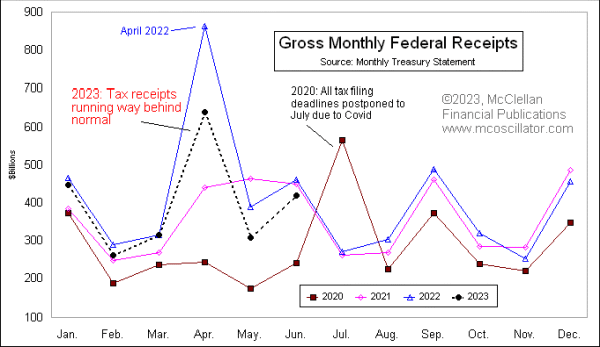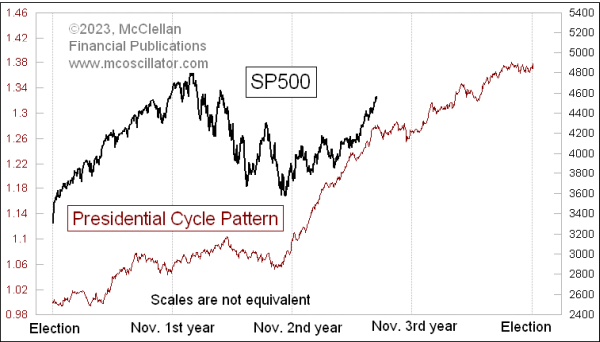
Later this year, there is going to be a big liquidity problem hitting the financial markets. And if you can believe the legacy media, it is all due to climate change, since these days they think that any weather phenomenon is proof of climate change. And our story starts out in California.
Starting on Jan. 8, 2023, much of California experienced flooding and mudslides due to much greater than normal rainfall. As a result of those weather events, the IRS announced that an extension would be granted to most Californians (ones who live in affected counties, which was most of them) for not just filing their Form 1040 tax returns, but also for paying any remaining 2022 taxes. See www.irs.gov/newsroom/irs-announces-tax-relief-for-victims-of-severe-winter-storms-flooding-and-mudslides-in-california
This is a big deal financially for the U.S. Treasury Department because California is by far the largest taxpaying state. According to Moneyrates.com, Californian taxpayers account for 15% of total tax receipts, in spite of having just under 12% of the U.S. population. There are more millionaires and billionaires in California than in other states. So if some portion of Californians get to delay paying their 2022 taxes, that can amount to a lot of money.
You can see that effect in this week’s chart above. The month of April usually is the largest month of the year for federal tax receipts, as taxpayers reach the deadline for paying taxes owed in the prior year. Those payments get added to the normal payroll deductions which wage earners have taken from their pay every month.
April 2022 saw a big surge in tax payments, in part because the stock market was up so nicely in 2021 and thus there were a lot of capital gains taxes to pay. The Fed’s quantitative tightening in 2022 knocked down stock market performance, and so there were not as many capital gains that stock traders had to pay taxes on in April 2023 with their tax returns. But April 2023 also saw Californians who owed taxes for 2022 get to sit on that money and not send it to Uncle Sam. So the April 2023 total of $638 billion that Uncle Sam collected was down 26% from April 2022.
In some recent years, when interest rates were almost nothing, it did not matter much if you paid early or late. But now when investors can earn more than 5% annual yield on T-Bills, it pays a lot more to refrain from sending your money to the IRS. And Californians who can manage such a delay appear to be doing so.
And it is not just the Californians’ annual tax payments. Because most Californians got to delay filing their 2022 taxes, that also means that they get to delay the calculation of what their 2023 quarterly estimated payments are going to have to be. According to the IRS announcement, “The Oct. 16, 2023, deadline also applies to the quarterly estimated tax payments, normally due on Jan. 17, April 18, June 15, and Sept. 15, 2023. This means that individual taxpayers can skip making the fourth quarter estimated tax payment, normally due Jan. 17, 2023, and instead include it with the 2022 return they file, on or before Oct. 16.”
So an unknown number of Californian tax filers are going to have a big tax bill coming due on Oct. 16, 2023, as they have to file their 2022 returns plus put together what would have been all of their quarterly estimated payments that they have not had to make thus far during 2023. That is going to be one giant windfall in October 2023 for the Treasury Department.
But here is why this event matters to the rest of us. Those California late payers are going to have to raise the money to make sure that their big October 2023 checks to the IRS clear. That is going to mean selling some stock, cashing out of money market funds, shifting money from savings to checking, and otherwise generally sending waves through the banking system to get their money organized so that they can cover those deferred payments. Writing a check to the IRS means that a bank then has to cover that check, and move money all around the system as the IRS cashes those checks.
The entire financial system has grown accustomed to that type of turbulence taking place in April every year. But this anomalous Oct. 16 for rich taxpayers in the most populous state is a non-standard type of ripple in the liquidity stream.
It is not clear exactly when this liquidity wave is going to go through the banking system, because different taxpayers have different needs for selling stock or otherwise moving money around. But the effect of these Californian taxpayers doing these money movements is going to be amplified by the normal late summer to autumn seasonal weakness.

Even in the bullish third year of a presidential term, which is what we are in now, there is a period of seasonal weakness lasting from July to October. How weak the market is during that period varies among the past presidential terms, but it is possible that those California tax payers may start to see their July gains slipping away during the slide into October, and they decide to sell stocks early to raise the money they need for their big upcoming tax payment October 16.
There is no way to quantify how much of an effect this will have, as we cannot see into the hearts and the bank accounts of all of those delayed filers in California. But it is going to have some meaningful effect that is an irregular feature of the normal calendar for banking and liquidity. By late October, all of the dust should have settled, and all of that moving around of money to cover tax payments will have simmered down, so stocks can get back to their normal seasonal strength starting by late October.
Views: 499